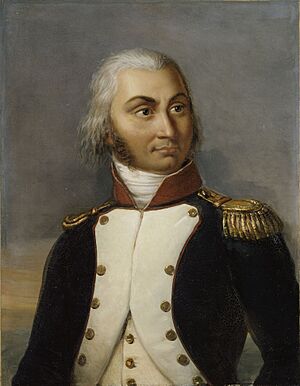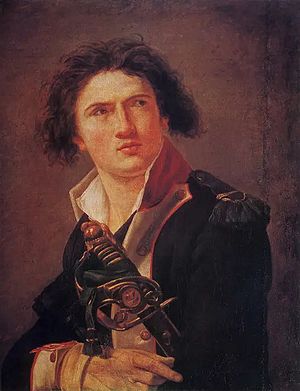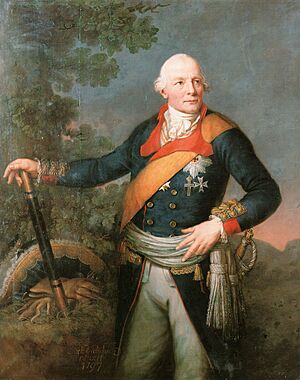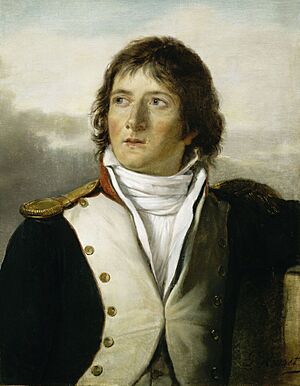Battle of Kaiserslautern (1794) facts for kids
Quick facts for kids Battle of Kaiserslautern (1794) |
|||||||
|---|---|---|---|---|---|---|---|
| Part of War of the First Coalition | |||||||
|
|||||||
| Belligerents | |||||||
| Commanders and leaders | |||||||
| Strength | |||||||
| Kaiserslautern: 46,000 Schifferstadt: 30,000 |
Kaiserslautern: 5,000 Schifferstadt: 20,000 |
||||||
| Casualties and losses | |||||||
| Kaiserslautern: 110 Schifferstadt: 900 |
Kaiserslautern: 1,000, 17 guns, 2 colors Schifferstadt: 500 |
||||||
The Battle of Kaiserslautern took place on May 23, 1794. It was a fight between the armies of Prussia and Saxony against the French Republic. The Prussian and Saxon forces were led by Wichard Joachim Heinrich von Möllendorf. They attacked a smaller French division led by Jean-Jacques Ambert.
Even though the Prussians tried to surround the French, most of the French soldiers managed to escape. However, the Prussians still won the battle. They caused many more casualties to the French and took control of the city of Kaiserslautern. This battle was part of the War of the First Coalition, which was a bigger conflict during the French Revolutionary Wars.
At that time, Kaiserslautern was part of a region called the Electoral Palatinate. Today, it is a city in Germany. On the same day, another battle happened nearby at Schifferstadt. An army of Austrian and Prussian soldiers attacked the French Army of the Rhine but was pushed back. After losing Kaiserslautern, the French armies moved back closer to their own border.
Contents
Why the Battle Happened
In December 1793, French armies had pushed Austrian and Prussian soldiers out of France. They then moved into enemy territory. In the spring of 1794, many French soldiers from the Army of the Moselle were sent to fight in other areas. This left the French defenses along the Rhine River weaker.
The Prussian army, led by Möllendorf, decided to take advantage of this weakness. They planned a major attack on the French forces. The main target was the French division led by General Ambert. Ambert's job was to try and save as many of his soldiers as possible.
Back in December 1793, the French had won a big victory at the Second Battle of Wissembourg. This forced the enemy armies to retreat across the Rhine River. The French then moved north and ended a siege at Landau.
The Prussian army was not fully committed to the war. Their leaders were arguing about whether to focus on fighting the French Revolution or on other matters, like dividing up Poland. Prussia even wanted to leave the war in 1793. However, United Kingdom paid them to keep 60,000 soldiers fighting in 1794. The Prussian King, Frederick William II, was more interested in Poland. Because of this, the Prussian army commander, Brunswick, quit his job.
By early 1794, the French Army of the Moselle had many soldiers, but not all of them were ready to fight. Many lacked basic supplies like boots. The government ordered an advance, but it was soon called off. The army then settled into winter camps. The French government started to distrust their successful general, Lazare Hoche. He was arrested and put in prison. Later, he was released after some political changes. On March 10, 1794, Jean-Baptiste Jourdan took command of the Army of the Moselle.
Jourdan then moved many soldiers from the Army of the Moselle to fight in the north. This left the eastern front, where Kaiserslautern was located, even more lightly defended. General Jean René Moreaux was left in charge of the remaining French forces in this area. He had about 25,000 soldiers spread out over a long line. The Army of the Rhine, led by Claude Ignace François Michaud, had about 38,500 men. These forces were also spread out. This made both French armies vulnerable to attack.
The Battle at Kaiserslautern
General Moreaux knew his defense lines were weak, but he didn't want to retreat. He might have been trying to hide the fact that Jourdan had moved so many troops north. The city of Kaiserslautern was defended by General Ambert's division. Ambert had only 5,000 soldiers. Many of them were new recruits, and some didn't even have weapons. One of his experienced officers was Nicolas Oudinot.
Moreaux sent a trusted officer, Laurent Gouvion Saint-Cyr, to check the situation. Saint-Cyr advised Ambert to retreat, but Ambert had orders to hold his position. Meanwhile, the Prussian commander, Möllendorf, decided to focus his main attack on Kaiserslautern.
Möllendorf gathered a large force of 46,000 Prussian and Saxon soldiers. They were organized into many battalions and squadrons. On May 23, Ambert and Saint-Cyr heard gunfire. They realized that the Army of the Rhine was being attacked to their east. Saint-Cyr convinced Ambert that it was time to retreat, as their own lines would soon be hit hard.
The Prussian attack began quickly. Saint-Cyr successfully managed the retreat of the French soldiers from their forward positions. Ambert then decided to retreat in two groups. He led the left group, and Saint-Cyr led the right group. Möllendorf wanted to surround and capture Ambert's entire division. He sent a division to block the French retreat. A special unit was also sent to cut off the connection between the two French armies, but this failed.
The French were helped by the local land. The roads they used to retreat were narrow, making it hard for the Prussians to follow quickly. Saint-Cyr's group managed to avoid being chased. They reached a town called Trippstadt just as it was being attacked by a Prussian division. This lucky timing allowed Saint-Cyr's group to easily push back the Prussians and escape.
Ambert's group had more trouble. His foot soldiers were supposed to hold the edge of a forest until the cavalry and artillery caught up. But by mistake, the foot soldiers kept marching. Prussian horsemen then attacked the French cavalry, causing chaos. The French cavalry panicked and ran through their own infantry, creating a mess.
However, Oudinot's battalion was tougher. They chased off the Prussian cavalry and went back to the edge of the woods. They found some abandoned artillery pieces but couldn't move them because the horses had been killed. As they continued their retreat, Oudinot's men ran into a Prussian roadblock. But they fought their way through it. The two French groups eventually met up again at Pirmasens. Some soldiers fled even further. At Kaiserslautern, the French lost about 1,000 men killed, wounded, or missing. They also lost 17 cannons and two flags. The Prussians had very few casualties, only about 110.
The Battle at Schifferstadt
Meanwhile, the Coalition attack along the Rhine River was stopped by French divisions led by Generals Louis Desaix and Pierre Marie Barthélemy Ferino. At Schifferstadt, the French lost 500 soldiers killed or wounded out of 20,000 men fighting. The Coalition forces suffered 900 casualties out of 30,000 men.
The Austrian forces involved were grenadiers from several infantry regiments. The Bavarian forces included two battalions of infantry and four squadrons of cavalry. The Prussian infantry included many battalions from different regiments. Their cavalry also included many squadrons of cuirassiers, dragoons, and hussars.
What Happened Next
After losing Kaiserslautern, the French Army of the Moselle moved back to the Saar River. The Army of the Rhine retreated behind the Queich River to Landau. Möllendorf, the Prussian commander, could have done better by following Jourdan's army to the north. His small victory at Kaiserslautern was overshadowed by Jourdan's much bigger victory at the Battle of Fleurus later on.
Möllendorf's attack quickly stopped. The Prussians then started building fortified camps to hold the land they had captured. The next major fighting in this area happened in July at the Battle of Trippstadt. After this battle, the French took back Kaiserslautern and moved forward again, erasing all the Coalition's recent gains.
General Moreaux praised Saint-Cyr and Oudinot for their actions during the battle. A French politician, Nicolas Hentz, insisted that Saint-Cyr be promoted to general because he was already leading a brigade. Saint-Cyr didn't want the promotion at first, but the politician made him accept it. Within a few days, Hentz promoted him again to a higher rank, general of division. Saint-Cyr was worried because another general with a similar name was in trouble, and he feared suspicion would fall on him. But Hentz told him that a brave man shouldn't be stopped from serving the Republic because of someone else in his family. Saint-Cyr's fears were understandable, as many generals were arrested or removed from their positions during this time. Saint-Cyr was given command of a division in the Army of the Rhine, and Oudinot was promoted to general of brigade in the Army of the Moselle.
Images for kids







